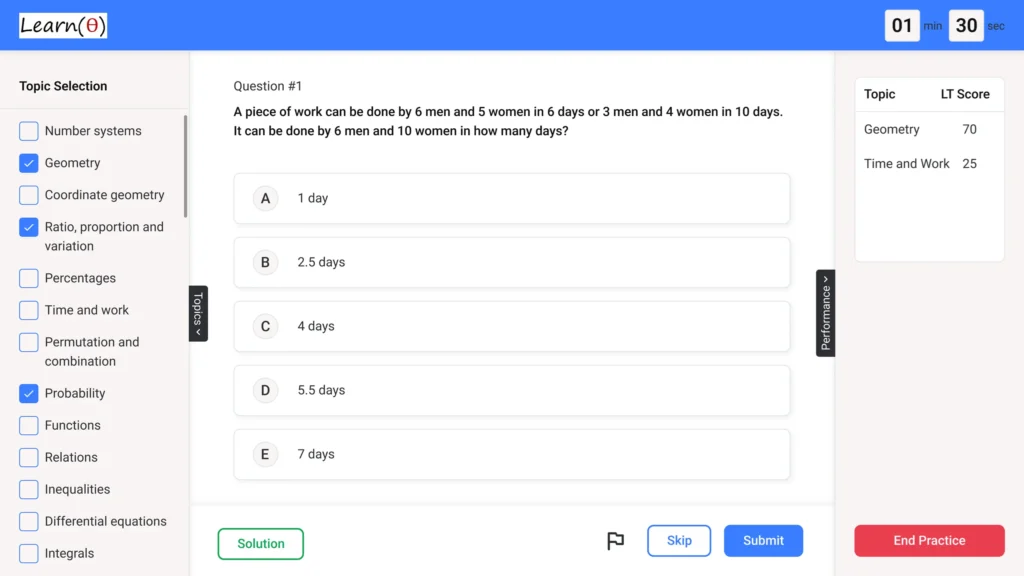Amdocs – Aptitude Questions & Answers for Placement Tests
Reviewing Previous Year Questions is a good start. Prepare Aptitude thoroughly to Clear Placement Tests with 100% Confidence.
Q.1 A fair six-sided die is rolled. Calculate the probability of rolling a number greater than 3, given that the number rolled is even.
Check Solution
Ans: C
The even numbers on a die are 2, 4, and 6. Out of these, only 4 and 6 are greater than 3. Thus, the probability is 2/3.
Q.2 A train travels 120 km in 2 hours and then 180 km in 3 hours. What is the average speed of the train for the entire journey?
Check Solution
Ans: B
Total distance = 120 + 180 = 300 km. Total time = 2 + 3 = 5 hours. Average speed = Total distance / Total time = 300 / 5 = 60 km/hr
Q.3 A bag contains 8 red balls, 6 blue balls, and 4 green balls. If two balls are drawn at random without replacement, what is the probability that both balls are blue?
Check Solution
Ans: B
Total number of balls = 8 + 6 + 4 = 18. Probability of drawing the first blue ball = 6/18 = 1/3. After drawing one blue ball, there are 5 blue balls and 17 total balls left. Probability of drawing the second blue ball = 5/17. Therefore, the probability of drawing two blue balls = (1/3) * (5/17) = 5/51 = 3/34.
Q.4 Find the odd man out. 123, 456, 789, 101, 234, 567, 890
Check Solution
Ans: A
All the numbers except 101 are formed by consecutive digits.
Q.5 The sum of a number and its five-eighths is 442. What is 30% of that number?
Check Solution
Ans: D
Let the number be x. x + (5/8)x = 442 (13/8)x = 442 x = 442 * (8/13) x = 272 30% of 272 = (30/100) * 272 = 81.6. The closest answer is 81.6
Q.6 Adding 15% of x to x is equivalent to multiplying x by what number?
Check Solution
Ans: B
Adding 15% of x to x means x + 0.15x = 1.15x. Therefore, it’s equivalent to multiplying x by 1.15.
Q.7 A shopkeeper sells 20 pens for Rs 100. He makes a profit of Rs 20 on each pen. If he sells 10 pens, what is his total profit?
Check Solution
Ans: A
Profit per pen is Rs 20. Therefore, profit on 10 pens = 10 * 20 = Rs 200
Q.8 The average age of a class of 30 students is 14 years. If the average age of the boys in the class is 15 years and the average age of the girls is 13 years, what is the number of girls in the class?
Check Solution
Ans: C
Let the number of boys be ‘b’ and the number of girls be ‘g’. We know that b + g = 30. The sum of ages of all students is 30 * 14 = 420. The sum of ages of boys is 15b and the sum of ages of girls is 13g. Therefore, 15b + 13g = 420. We also know b = 30 – g. Substituting, 15(30 – g) + 13g = 420, 450 – 15g + 13g = 420, 2g = 30, g = 15.
Q.9 In a school, 30% of the students are girls. The number of boys who play football is 2/3 of the number of girls, which is 45. The number of students who don’t play football is 1/4 of the total number of students. How many students are in the school?
Check Solution
Ans: C
Let G be the number of girls and B be the number of boys. Girls who play football = 45, so total number of girls (G) = 45. 3 = 135. Then the number of boys who play football= 2/3 * G implies the number of girls is 45. Total girls = 45 / 30% = 150. Number of boys who play football is 2/3 of girls which is 45. Since it’s given as 45. Boys who don’t play football is 1 – (1/4) = 3/4. Total boys = 45 * 3/2 = 67.5 , the number of boys playing football is 2/3 of the girls. Number of girls = 45 / (2/3) = 67.5 . Let G be girls. 45= 2/3G -> G= 45*3/2 -> G = 67.5 which does not seem reasonable. The number of boys who play football = 2/3 * 45 = 30. Thus number of girls is 45. So 30%=45 therefore 100% = 150. Total number of students = 150. Total students not playing football is 1/4 of the total. So total students playing football is 3/4. Also girls = 45 boys playing football= 30. The problem states, the number of boys playing football is 2/3 of the number of girls. Number of girls = 45*3/2=67.5 . Incorrect assumption. Number of boys playing football = 30. Number of girls = 45. 30% = 45. Total girls = 150. So 45= 30% . total number of girls. Total students= 3/4 = Total playing football = boys playing football + girls= 30+45 = 75. Hence, if 75 is 3/4th, total is 100. Let total = x. x/4 are not playing. Boys + girls = 3/4x, girls =45 boys football=30. Total football = 75. 3/4x = 75, implies, x=300 .
Q.10 The average weight of 20 students in a class is 50 kg. The average weight of 10 students out of these, who are boys, is 60 kg. What is the average weight of the girls in the class?
Check Solution
Ans: A
Total weight of 20 students = 20 * 50 = 1000 kg. Total weight of 10 boys = 10 * 60 = 600 kg. Total weight of 10 girls = 1000 – 600 = 400 kg. Average weight of girls = 400 / 10 = 40 kg.
Q.11 By selling a pen, Priya incurred a loss equal to 1/6th of the selling price. If she sold it for Rs 150, what was the cost price?
Check Solution
Ans: C
Let the selling price be SP and the cost price be CP. Loss = CP – SP. Given loss = (1/6) * SP. So, CP – SP = SP/6. CP = SP + SP/6 = 7SP/6. SP = 150, so CP = (7 * 150)/6 = 175.
Q.12 Directions: One statement is given followed by two conclusions, I and Il. You have to consider the statement to be true, even if it seems to be at variance from commonly known facts. You are to decide which of the given conclusions can definitely be drawn from the given statement. Statements: Increased urbanization is causing a rise in air pollution levels in major cities, negatively impacting public health. Conclusions: I. The government should implement stricter environmental regulations to curb pollution. II. People living in urban areas are likely to experience more respiratory illnesses.
Check Solution
Ans: B
Conclusion II directly follows from the statement. Conclusion I suggests a possible action based on the problem but is not explicitly stated.
Q.13 Who is the tallest among E, F, G, and H? Statements: I. E is shorter than F and G. II. H is taller than G.
Check Solution
Ans: D
Statement I tells us E is shorter than F and G, but doesn’t provide any information about H or the relative heights of F and G. Statement II says H is taller than G, but gives no information about E or F. Combining both statements, we know: E < F, G and H > G. We still do not know the relationship between F and H or G and H. Therefore, we cannot determine who is the tallest.
Q.14 P is the sister of Q; Q is the husband of R; R is the daughter of S. How is P related to S?
Check Solution
Ans: B
Since Q is the husband of R and R is the daughter of S, then Q is also the son-in-law of S. Since P is the sister of Q, P is also the sister-in-law of R and the sibling of the son-in-law of S. Thus, P is the daughter of S.
Q.15 Pointing to a photograph, a man says, “She is the granddaughter of my grandfather’s only son.” How is the woman in the photograph related to the man?
Check Solution
Ans: A
The man’s grandfather’s only son is the man’s father. Therefore, the woman is the granddaughter of the man’s father, making her the man’s sister.
Q.16 How is A related to C? Statements: I. A is the brother of B and B is the daughter of C. II. C is the mother of B and D.
Check Solution
Ans: A
From statement I, A is the brother of B. B is the daughter of C. Therefore, A is the son of C. From statement II, C is the mother of B and D. Therefore, statement II also implies that A could be the son/daughter of C, but we cannot determine A’s exact relation. Both statements are needed to reach to an answer.
Q.17 Select the option which is the odd one out.
Check Solution
Ans: D
Chess is a game played on a board, while the others are sports played on a field or court.
Q.18 Can Sarah purchase the discounted laptop? Statements: I. The laptop is 20% off. II. Sarah has a coupon for an additional 10% off the discounted price, and the coupon is valid.
Check Solution
Ans: D
To know if Sarah can purchase the laptop, we need information about the price and whether she can afford it. Statement I tells us about a discount. Statement II provides further discount information. We still don’t know if she can actually afford it.
Q.19 How is P related to Q? Statements: I. P says, “Q is my mother’s sister.” II. Q says, “I have only one niece.”
Check Solution
Ans: C
Statement I implies Q is P’s aunt. Statement II means Q’s sibling’s daughter is a niece. Therefore, either statement alone is not sufficient as we need both to get the answer.
Q.20 Select the one which is different from the other three alternatives.
Check Solution
Ans: D
Potato is a root vegetable that grows underground, while the other options (carrot, spinach, and radish) are leafy green vegetables.
Q.21 In a certain code, BLANK is written as 211411 and MIST is written as 1391920. How is STALK written in that code?
Check Solution
Ans: B
Each letter is replaced by its position in the alphabet.
Next: Aricent Aptitude Questions
Refer Company wise Aptitude Questions
Practice 1000s of Aptitude Questions with Answers for Quant, Reasoning & Verbal
Fastest Way to Crack Aptitude Tests – LearnTheta’s AI-Practice!

✅ All Topics at One Place

🤖 Adaptive Question Practice

📊 Progress and Insights